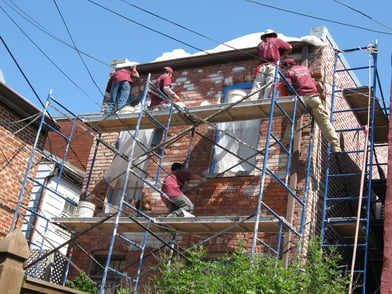Maintaining a historic brick house in DC takes constant attention. Many homeowners consider it a labor of love. There are some useful terms and facts to be aware of as you begin learning about your old brick home.
Tuckpointing Defined
An old home’s deteriorating, patched mortar calls for repointing or tuckpointing to restore the original mortar's look and function to historical standards.
Tuckpointing - sometimes called repointing - removes and replaces the deteriorated, damaged, and missing mortar in between brick, block, stone, and replacing it with a historically accurate mix based on the age and porosity of the old bricks. Tuckpointing will protect your home for years to come. It will also transform and refresh the look of your older brick or stone house.
The Importance of Lime Mortar
Some homes in the DC area have been patched throughout the years using inappropriate or historically inaccurate materials such as Portland mix cement. Such treatment not only looks poorly, it inevitably leads to brick damage a year or two down the road. As a result, we are often called in to repoint entire walls that have become a patchwork of old “repair” jobs, new cracks, and spalling.
The mortar used in most of DC’s historic brick buildings (pre-1930’s) is lime mortar, a mixture of lime and sand. Although Portland cement is compatible with bricks manufactured today, it is extremely hard and harmful to softer, old brick. Therefore, patching old mortar joints with modern materials should not be a substitute for historically appropriate tuckpointing.
Most mortar used in older DC homes is lime mortar, which slowly deteriorates with pressure and water exposure. However, it's easier and more cost-effective to repair mortar than to replace cracked bricks. Mortar deterioration is normal, but with proper maintenance, including tuckpointing, a structure will only require major work every 50-100 years and last for centuries.
What To Do About Damaged Bricks?
Replacing damaged bricks, especially on historically significant homes, retaining walls or other hardscaping is a frequent challenge. Tuckpointing professionals know that older brick home restoration sometimes requires a trip to an architectural salvage yard to get replacements. Although experienced, well-established firms will frequently maintain stocks of similar bricks salvaged from other projects.
Closing Thoughts
Tuckpointing is a labor-intensive job best left to professionals. A seasoned crew that knows how to do it without damaging the protective fire skin of your bricks and who uses historically appropriate materials is essential. Your brick structures and building facade can last for centuries to be enjoyed by generations to come if given the proper care.
Renaissance Development professionals are experts in restoring and maintaining historic brick homes and structures. Contact us for a consultation regarding the care of your brick home or structures today.
8/19/21 11:34 AM

